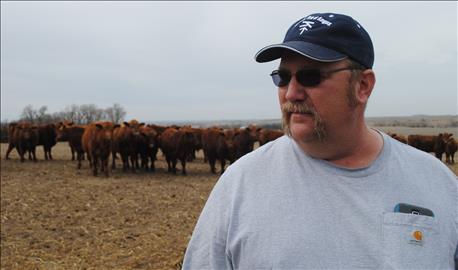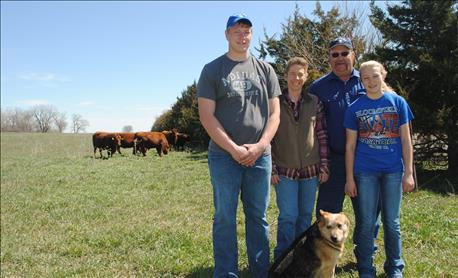
Kelly and Cindy Bruns of Bloomfield have come a long way from where they were on their farm 20 years ago. Back then, they were milking Jersey cows with Kelly's brother, Kirk and his father, Bob. The Bruns Dairy had one of the top producing Jersey dairy herds in the state. Yet, for all of their production and quality awards, they were still searching for more ways to stay profitable and to work grass into their conventional farming operation.

BEING RESILIENT: Cindy and Kelly Bruns of Bloomfield started in the dairy business. Over the years they have operated a grass-based, seasonal Jersey dairy, but times and turns in the ag economy have led them into the purebred beef business. They believe that being open-minded and forward-thinking helps a farming operation take advantage of available resources, overcome challenges and be more resilient.
They eventually seeded much of their crop land into grass and built and operated a seasonal, grass-based dairy with a herd of 100 Jersey-cross milk cows. That move opened the doors for the family to gain marketing opportunities for certified organic milk. But the path for the Bruns family has not always been easy and it often has taken turns that required the family to be flexible enough to take advantage of their resources.
Fast forward 20 years and things have changed. The former dairy producers are now purebred beef producers, raising Red Angus breeding stock. But one thing hasn't changed. Once the family worked grass and grass farming into their operation, they haven't looked back.
"I only farm about 20 acres of crops which we seed to oats that is grazed by the cattle," Kelly Bruns says. "The rest we are farming with cows and growing grass. The cows are our combine."

GOOD ADVICE: "If you are producing for a specialty market, if the money isn't there, you need to go somewhere else," says Kelly Bruns of Bloomfield. "We basically traded cattle. Because of my dairy experience, I knew all about genetics and artificial insemination. If we were going to be in beef, we needed to be in the purebred business."
The Bruns family didn't discover grass farming by accident. It took a major shift in their farming philosophy. Kelly became acquainted with his neighbor, then University of Nebraska Extension educator in Knox County and grazing expert, the late Terry Gompert. "I spent a lot of evenings talking about grass farming around Terry's fireplace," Bruns says. Acknowledging the value of soil health and grass in the operation and learning how to better manage grass through intense rotation, the family made a change. Gompert, who passed away in 2011, became a mentor during this period for Bruns, and he continued to influence how Bruns developed a long-term plan. The family converted from a conventional dairy to a seasonal, grass-based dairy, building a small dairy barn and covered, outdoor milking parlor in the middle of their pasture.
~~~PAGE_BREAK_HERE~~~
This was a novel idea for dairy production, but the family found that it worked. Cows were quiet, moving directly from fresh paddocks of grass to the milking parlor. When milk inspectors first began to visit the new Bruns dairy, they didn't know quite how to inspect this unique set up. Over time, the family gained management experience with their new dairy and earned a contract from a certified organic processor.

ALL IN THE FAMILY: For the Bruns family, which includes Cindy and Kelly Bruns and their children Cole and Kate, grass farming is the center of their operation. "I only farm about 20 acres of crops which we seed to oats that is grazed by the cattle," says Kelly Bruns. "The rest we are farming with cows and growing grass. The cows are our combine."
Those were good days in the dairy business for the family, Bruns says. They had locked-in profits doing what they wanted to do. They improved their genetics to maintain a herd of milk cows that handled the grazing environment, were easy to keep and maintained high levels of production.
But after two years under contract, the organic milk market became depressed and their processor pulled away from Bruns Dairy and several similar dairies in the region. Almost overnight, Kelly and Cindy lost their lucrative market, so they dried up their cows and sold their entire Jersey herd to another dairy in Missouri. All they had left was the grass.
Bruns' brother, Kirk and his wife, Kristi moved west and purchased a farm near Bassett. Kelly and Cindy purchased Kirk's quarter section and moved onto that place. "A few years earlier, we had begun to purchase a few purebred Red Angus heifers to breed," Bruns says. "We had started to diversify, but we didn't realize how important that was going to be."
An important lesson was learned. "If you are producing for a specialty market, if the money isn't there, you need to go somewhere else," Bruns says. "So, we basically traded cattle. Because of my dairy experience, I knew all about genetics and artificial insemination," he explains. "If we were going to be in beef, we needed to be in the purebred business."
Since then, the family has built up their purebred Red Angus herd. This year, they will conduct their seventh annual production bull sale. After their first sales were held in the spring, Bruns decided last year to move to a fall production sale date. "We want to calve on grass, so we calve in April," he says. "We found ourselves feeding the yearling bull calves too hard to get them to the right size for a March sale," Bruns says. "With a fall sale, our bulls are 18 months old and are able to mature naturally, so we don't have to push them as hard and they are in better shape at sale time for our customers."
~~~PAGE_BREAK_HERE~~~
It's all about the momma cow, according to Bruns. With higher feed and input costs, he sees strong movement in the industry toward moderately-sized, easy keeping mothers that do well on range.
As for grass management, Bruns utilizes K-line irrigation and a traveling water gun on some paddocks and has learned to utilize every growing forage resource at the optimal time. With a lower land base for his herd, he now sends some cow-calf pairs to a friend who custom grazes, so they can be rotated on grass throughout the season. "That's the key to the whole deal," Bruns says. "We just want to keep getting better about doing it."
Having experienced unexpected turns in their operation, Bruns stays optimistic. "You have to be pretty open-minded and forward-thinking," he says. But the payoff is increased resilience and an ability to roll with the punches.
You can learn more about the Bruns operation by reading the cover story in the May print issue of Nebraska Farmer.
About the Author(s)
You May Also Like






